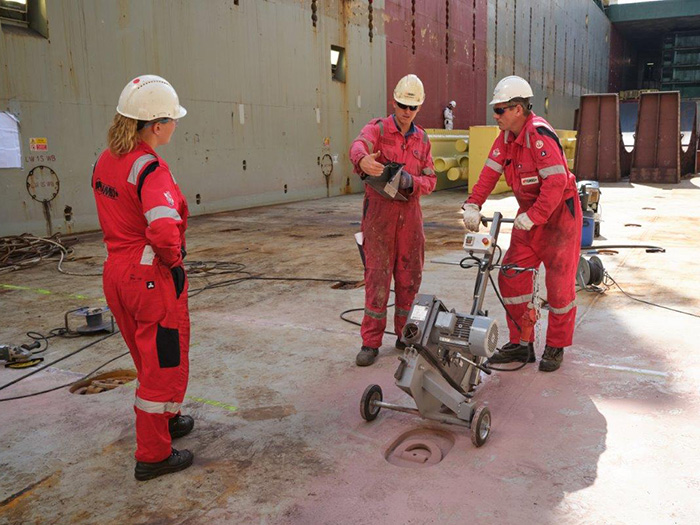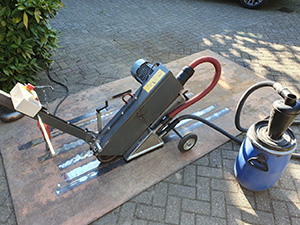
VIDEO: Jumbo Chief Officer comes up with innovative answer to flash rust
Written by Nick Blenkey
Users can walk behind prototype rather than working on hands and knees with an angle grinder. [Image: Jumbo Shipping/Bob Heikloop]
An in-house development from Schiedam, Netherlands, headquartered Jumbo Shipping promises to go a long way to solving the issue of persistent flash rust caused by the removal of temporary welded securings on board its fleet of heavy lift vessels.

The prototype device was developed by Jumbo Chief Officer and part-time Master’s student Bob Heikoop. Initial results show that the device, a modified belt sander, is not only faster than existing methods of removing temporary weldings, it is also cleaner for the environment, healthier for users, and improves the appearance of the ship.
While Jumbo’s nine heavy lift vessels are technically and operationally in excellent condition, their decks and hull sides have a decidedly rusty appearance, due to flash rust. This has the potential to be detrimental to Jumbo’s reputation for the proper management of its assets.
Flash rust is caused by the corrosion of steel particles dispersed during the removal of temporary welded securings, a process requiring the use of cutting, gouging and grinding tools. The steel and paint particles formed during the removal process can also be harmful to the environment and to human health. Another negative consequence: the removal of the temporary welded securing is a time-consuming and uncomfortable task for crews.
PRACTICAL PROBLEM WITH GREEN POTENTIAL
Jumbo came up with a solution when Chief Officer Bob Heikoop, who had started a Master’s degree in Marine Shipping Innovations at the Maritime Institute Willem Barentsz in 2018, was looking for a subject on which to focus his final thesis.
“I wanted to combine a practical problem that Jumbo was facing with a subject that was important to society in terms of sustainability,” he says. “Solving the flash rust problem could achieve both of these. First: Reducing our environmental footprint by reducing the release of paint and steel particles. Second: Preventing, or at least reducing the rusty appearance.”
INNOVATIVE MODIFICATIONS
After concluding that welding was the quickest, most efficient and most cost-effective way of securing the temporary sea-fastenings, the main question Heikoop needed to address was finding a new way to remove the sea-fastenings that simultaneously collected steel and paint particles.
The solution was a Fein GIMS-75 belt sander, which Heikoop modified with the addition of a spark/molten steel particle catcher, an extraction system, and a collection container. The performance of the resultant prototype device was then verified in terms of four separate parameters: i) Removal of paint layer, ii) Removal of top part of temporary welding, iii) Removal of bottom part of temporary welding and iv) Flattening of surrounding paint layer.
The results were overwhelmingly positive, says Jumbo.
“We were very enthusiastic about the outcome,” says Heikoop. “The modifications made to the GIMS-75 mean that it catches and removes the steel and paint particles. In terms of sustainability, there are no particles entering the environment. But it is also much faster than the current way of working – on average, three times as fast – which makes it very interesting commercially.”
The prototype also yielded health benefits.
“For the person using the existing method, this meant spending the whole day working on your hands and knees with an angle grinder on the deck of the ship,” says Heikoop. “However, users can walk behind this prototype in a standing position. It is better ergonomically and it produces far fewer vibrations.”
VIDEO: Jumbo Chief Officer comes up with innovative answer to flash rust




